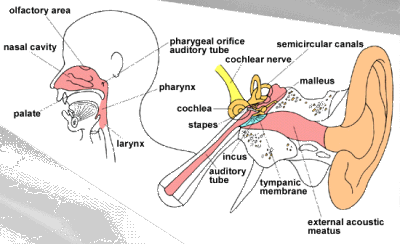
Ear, Nose, and Throat Facts

What is the ear?
The ear is the organ of
hearing. It is part of the peripheral nervous system, and consists of:
- external or outer ear, consisting of:
- auricle - the visible, outside portion of the ear
- external auditory canal or tube
- middle ear (tympanic cavity), consisting of:
- tympaum or ear drum, consisting of:
- auditory canal or tube
- tympanic membrane
- ossicles - three joined-together bones called:
- malleus
- incus
- stapes
The eustachian tube is a canal that connects the middle ear with the nasopharynx.
- inner ear, consisting of:
- cochlea (contains the sensory nerves for hearing)
- vestibule (contains sensory receptors for balance)
- semicircular canals (contain sensory receptors for balance)
What is the nose?
The nose is the organ of smell and is part of the peripheral
nervous system. The external part of the nose lies above the roof of the
mouth. The nose consists of:
- external meatus - triangular-shaped projection in the center of the face
- external nostrils - two chambers divided by the septum
- septum - made up primarily of cartilage and bone and covered by mucous membranes. The cartilage also gives shape and support to the outer part of the nose.
- nasal passages - passages that are lined with mucous membranes and tiny hairs (cilia) that help to filter the air
- sinuses - four pairs of air-filled cavities that are also lined with mucous membranes
What is the throat?
The throat is a ring-like muscular tube that
acts as the passageway for air, food, and liquid. The throat also helps in
forming speech. The throat consists of:
- larynx - houses the vocal cords and is crucial to speech and breathing. The larynx also serves as a passageway to both the trachea (windpipe to the lung) and the esophagus (canal to the stomach).
- epiglottis - located above the larynx and works with the larynx and vocal cords to push the food into the esophagus, therefore keeping food from entering the windpipe.
- tonsils and adenoids - made up of lymph tissue and are located at the back and the sides of the mouth. They protect against infection, but generally have little purpose beyond childhood.
